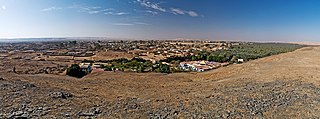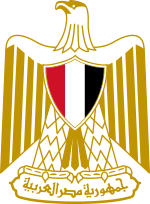
Saqqara, also spelled Sakkara or Saccara in English, is an Egyptian village in the markaz (county) of Badrashin in the Giza Governorate, that contains ancient burial grounds of Egyptian royalty, serving as the necropolis for the ancient Egyptian capital, Memphis. Saqqara contains numerous pyramids, including the Pyramid of Djoser, sometimes referred to as the Step Tomb, and a number of mastaba tombs. Located some 30 km (19 mi) south of modern-day Cairo, Saqqara covers an area of around 7 by 1.5 km.

Zahi Abass Hawass is an Egyptian archaeologist, Egyptologist, and former Minister of State for Antiquities Affairs, serving twice. He has also worked at archaeological sites in the Nile Delta, the Western Desert, and the Upper Nile Valley.
Teti, less commonly known as Othoes, sometimes also Tata, Atat, or Athath in outdated sources, was the first king of the Sixth Dynasty of Egypt. He was buried at Saqqara. The exact length of his reign has been destroyed on the Turin King List but is believed to have been about 12 years.

The Supreme Council of Antiquities (SCA) was a department of the Egyptian Ministry of Culture from 1994 to 2011. It was the government body responsible for the conservation, protection and regulation of all antiquities and archaeological excavations in Egypt, and was a reorganization of the Egyptian Antiquities Organisation, under Presidential Decree No. 82 of Hosni Mubarak.

Bahariya Oasis is a depression and a naturally rich oasis in the Western Desert of Egypt. It is approximately 370 km away from Cairo. The roughly oval valley extends from northeast to southwest, has a length of 94 km, a maximum width of 42 km and covers an area of about 2000 km².

The Imhotep Museum is an archaeological museum located at the foot of the Saqqara necropolis complex, near Memphis in Lower Egypt.

The Statue of Ramesses II is a 3,200-year-old figure of Ramesses II, depicting him standing. It was discovered in 1820 by Giovanni Battista Caviglia at the Great Temple of Ptah near Memphis, Egypt. It is made from limestone and weighs 83 tons.
Qar was a doctor during the Sixth Dynasty of Egypt, which lasted from about 2350 to 2180 BC. He was the royal physician.

The Ministry of Awqaf of Egypt is one of ministries in the Egyptian government and is in charge of religious endowments. Religious endowments, awqaf, are similar to common law trusts where the trustee is the mosque or individual in charge of the waqf and the beneficiary is usually the community as a whole. Examples of waqfs are of a plot of land, a market, a hospital, or any other building that would aid the community.
KV65 is a tomb commencement located in the Western Valley of the Kings, near Luxor, Egypt. It was discovered in 2018 by a team led by the Egyptologist Zahi Hawass and announced in 2019. The tomb consists of a sloping rectangular pit of similar proportions to the entrances of royal tombs from the Eighteenth Dynasty. It contained a variety of items consisting of construction tools, pieces of rope, animal bones, leather, pottery, and food remains. It may represent a cache where the remains of a funerary feast and embalming material was buried, similar to the embalming cache of Tutankhamun, KV54.
Sesheshet, occasionally known as Sesh, was the mother of King Teti, the first and founding pharaoh of the Sixth Dynasty of Ancient Egypt. She was instrumental in enabling her son to gain the throne and reconciling two warring factions of the royal family.
Behenu was an ancient Egyptian queen of the Sixth Dynasty. She is thought to have been the wife of either Pepi I or of Pepi II.

Smart Village is a high-technology business district in the city of 6th of October in Giza Governorate, Egypt, established by Presidential Decree no.355 in 2000, with activities starting in 2001. It is a business district with office buildings, retail shops, entertainment, factories and green spaces. It is located on the Cairo-Alexandria Desert Road, slightly west of Cairo, and occupies an area of 450 feddans. Its owned by Smart Villages Development and Management Company.

The Ministry of Tourism of Egypt was a part of the Cabinet of Egypt and was responsible for tourism in Egypt. On 14 January 2018, Rania Al-Mashat was appointed Minister of Tourism until December 2019. The Ministry of Tourism then merged with the Ministry of Antiquities with The Minister of Antiquities, Khaled al-Anani becoming the minister of the merged ministry: Ministry of Tourism and Antiquities.
Mohamed Arab is a veteran politician, who has served as Egypt's former minister of culture in different cabinets, including the Beblawi cabinet.

The mask of Tutankhamun is a gold funerary mask of the 18th-dynasty ancient Egyptian pharaoh Tutankhamun. After being buried for over 3,000 years, it was excavated by Howard Carter in 1925 from tomb KV62 in the Valley of the Kings and is now in the Egyptian Museum in Cairo. The death mask is one of the best-known works of art in the world and a prominent symbol of ancient Egypt.

The National Museum of Egyptian Civilization (NMEC) is a large museum located in Old Cairo, a district of Cairo, Egypt. Partially opened in 2017, the museum was officially inaugurated on 3 April 2021 by President Abdel Fattah El-Sisi, with the moving of 22 mummies, including 18 kings and four queens, from the Egyptian Museum in central Cairo, in an event termed the Pharaohs' Golden Parade. The museum displays a collection of 50,000 artifacts, presenting the Egyptian civilization from prehistoric times to the present day.
Khaled al-Anani is an Egyptian egyptologist and politician. He is the current Minister of Tourism and Antiquities.
The archaeology of Ancient Egypt is the study of the archaeology of Egypt, stretching from prehistory through three millennia of documented history. Egyptian archaeology is one of the branches of Egyptology.











